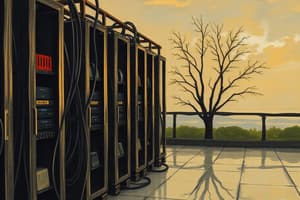Podcast
Questions and Answers
What is the primary use of network cabinets?
What is the primary use of network cabinets?
- Mounting servers and power supplies
- Storing backup data
- Cooling computer systems
- Mounting routers, switches, and patch panels (correct)
What is a distinguishing feature of server cabinets in terms of size?
What is a distinguishing feature of server cabinets in terms of size?
- They can only accommodate 1U mounts.
- They are roughly 36 inches deep. (correct)
- They are usually less than 24 inches wide.
- They are more shallow than network cabinets.
How is the height of mountable equipment in cabinets expressed?
How is the height of mountable equipment in cabinets expressed?
- In inches only
- In standard sizes
- In centimeters
- In Rack Units or U (correct)
What is typically found at the front of server cabinets to assist with airflow?
What is typically found at the front of server cabinets to assist with airflow?
What does the 'U' designation refer to when purchasing mountable equipment?
What does the 'U' designation refer to when purchasing mountable equipment?
Which equipment is more likely to be mounted on server cabinets compared to network cabinets?
Which equipment is more likely to be mounted on server cabinets compared to network cabinets?
What is a common depth for network cabinets?
What is a common depth for network cabinets?
What kind of equipment might require extension brackets for mounting?
What kind of equipment might require extension brackets for mounting?
What is the purpose of rails mounted on servers?
What is the purpose of rails mounted on servers?
What does the term '1U' refer to in server equipment?
What does the term '1U' refer to in server equipment?
Why is it important to lock the doors of cabinets housing networking equipment?
Why is it important to lock the doors of cabinets housing networking equipment?
What does the light indicator on a patch panel signify?
What does the light indicator on a patch panel signify?
What does 'hot-swappable' mean in the context of server hard drives?
What does 'hot-swappable' mean in the context of server hard drives?
What is a main precaution to take when pulling out servers from a rack?
What is a main precaution to take when pulling out servers from a rack?
During which hours do some organizations typically maintenance on mounted networking equipment?
During which hours do some organizations typically maintenance on mounted networking equipment?
What is a common troubleshooting step for network connectivity issues?
What is a common troubleshooting step for network connectivity issues?
What would happen if a loose cable comes disconnected from the networking equipment?
What would happen if a loose cable comes disconnected from the networking equipment?
What type of equipment is characterized as having small dimensions and often requires mounting extensions?
What type of equipment is characterized as having small dimensions and often requires mounting extensions?
Flashcards are hidden until you start studying
Study Notes
Network and Server Cabinets
- Network and server cabinets are often called racks.
- Network and server cabinets are ideal for mounting routers, switches, and other equipment.
- Network cabinets are usually shallower than server cabinets, typically less than 31 inches deep.
- Network cabinets commonly have glass or clear plastic front doors.
- Network cabinets are better suited for equipment that doesn't generate as much heat.
- Server cabinets are usually used for servers, power supplies, monitors, and similar equipment.
- Server cabinets are larger than network cabinets, about 24 inches wide and 36 inches deep.
- Server cabinets typically have perforated front and rear panels to allow airflow and prevent overheating.
- Large organizations and data centers dedicate significant effort to selecting the right cabinet for their specific equipment needs.
Mounting and Sizing
- Mountable equipment often references 1U, 2U, or 6U, which refers to the height of the equipment in Rack Units (RU).
- 1U is equivalent to 1.75 inches or 44 millimeters.
- The width of most rack-mount equipment is a standard 19 inches, although some might be 23 inches or more.
- Equipment smaller than 19 inches may come with extension brackets to fit in a standard 19-inch cabinet.
- Servers often have rails mounted on the sides, allowing them to slide in and out for easier maintenance.
- Cabinets typically have locks to prevent unauthorized access or accidental equipment disengagement.
LabSim Networking Equipment
- LabSim includes various networking equipment mounted on a rack.
- The LabSim environment allows users to view equipment details, zoom in on components, and learn about specific specifications.
- Patch panels are used to organize and connect network cables.
- Lights on patch panels indicate whether a port is connected.
- Hot-swappable hard drives allow replacement while servers are powered on and running.
- Uninterruptible Power Supplies (UPS) provide backup power to connected devices in case of power outages.
Warnings and Troubleshooting
- When pulling out a server, ensure networking cables are not obstructing its movement.
- Cable clamps should be checked to prevent unintentional disconnections.
- Exercise caution when working on equipment to avoid accidentally pulling loose connections.
- Troubleshooting network connectivity issues might involve checking the patch panel and related connections.
- Most organizations have specific time windows for working on mounted networking equipment for safety and maintenance purposes.
Studying That Suits You
Use AI to generate personalized quizzes and flashcards to suit your learning preferences.




